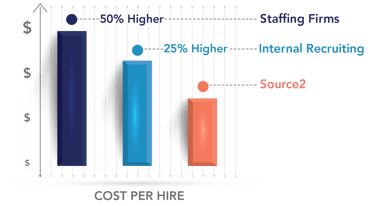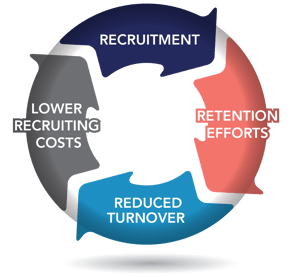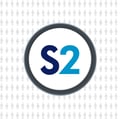
In previous articles in this series, we’ve discussed unburdening HR, flexibility, ease of implementation, and time efficiencies gained through technology as valid cases for Recruitment Process Outsourcing. While these are all important aspects when choosing an RPO partner, costs always matter. On average, Source2 saves our clients 25%-50% compared to internal recruiting and usage of search and staffing firms.
Whether it’s the hard costs of finding and keeping candidates or the opportunity costs of being understaffed, cost is often the driving factor in outsourcing recruiting processes. How is it possible for Source2 to lower recruiting costs for our clients by 25%-50%? Through reliance on lean and agile process methodologies, combined with the integration of AI and other technologies, Source2 addresses our clients’ high-volume hiring needs of frontline employees with speed and efficiency.
Before we jump into the solutions that address costs, it’s worthwhile to quickly review all that goes into calculating your average cost-per-hire, as it’s often considerably more than anticipated.
Calculating Cost-Per-Hire
According to the Society for Human Resource Management (SHRM), the national average cost-per-hire is in excess of $4,000. This is nearly three times the amount spent on training per employee (see Bersin by Deloitte, Deloitte Consulting LLP). What goes into cost-per-hire and how can you accurately calculate yours?
- External Recruiting Costs. Sourcing, job boards, advertising, marketing, technology, assessments, and background checks, as well as spending with search and staffing firms.
- Internal Recruiting Costs. In-house hiring managers and recruiting staff, systems, technology, and referral rewards.
- Hiring Metrics. Time frame to fill headcount, attrition rate, candidate quality, and turnover.
Add external and internal recruiting costs for your total spend on recruiting, and divide that sum by the number of hires made in a specified time period you wish to measure. This provides you with your average cost-per-hire. (Glassdoor)
With these costs and metrics in mind, let’s dive further into the various costs associated with recruiting and effective Source2 solutions for cost reductions.
Variable Cost
 Source2 replaces the high fixed costs associated with internal recruiting, such as full-time staff, marketing and advertising, and subscription services, with variable costs in which the client only pays a fee upon successful hiring.
Source2 replaces the high fixed costs associated with internal recruiting, such as full-time staff, marketing and advertising, and subscription services, with variable costs in which the client only pays a fee upon successful hiring.
Based on volume of hires and the relative difficulty of filling open positions, Source2’s typical cost-per-hire fee is structured to be in the range of 2%-8% of the annual wages of newly hired employees.
- Source2’s cost-per-hire fees are inclusive of all advertising, marketing, technology, recruiters, and process management costs.
- Economies of scale enable our offering of sliding scale fee structures that decrease with increasing hire volume.
Opportunity Cost
Source2's recruiting solutions are designed for speed. Our recruiting expertise, focus on frontline positions, and experience across many industries enable best practices and greater process efficiencies:
- Reduction of time-to-fill for positions through lean process design and a comprehensive tech stack, meaning positions are open for less time and loss of productivity is minimized.
- Capture of more highly qualified candidates and reduction of candidate fallout through innovative technology and strategic platform messaging, such as our AI-driven Text-to-Apply system and Virtual Hiring Event structure.
- Unburdening of HR personnel by transferring time-consuming recruitment tasks to Source 2 and our utilization of AI and automated processes, allowing HR to focus on other priorities and strategic tasks.
Turnover Cost
 Our recruitment efforts have a proven track record in reducing employee turnover, but retaining employees requires efforts beyond the first day of work:
Our recruitment efforts have a proven track record in reducing employee turnover, but retaining employees requires efforts beyond the first day of work:
- Engaging with new employees at key milestones through personalized AI technology to gauge job satisfaction and prevent turnover.
- Gathering real-time data through current employee surveys and departing employee exit interviews to allow managers to proactively address issues.
- Improving employer reputation and attracting top candidates by identifying positive employee experiences and facilitating public reviews on Glassdoor and Indeed, as well as ensuring employer information is current, accurate, and visually easy to navigate for prospective employees.
In our next article, we’ll take a closer look at lean process and performance tracking, but if you’d like more information on this or other topics now, connect directly with a member of our executive team by emailing solutions@source2.com or by completing our contact form.
Tags:

Oct 8, 2020 9:00:00 AM
